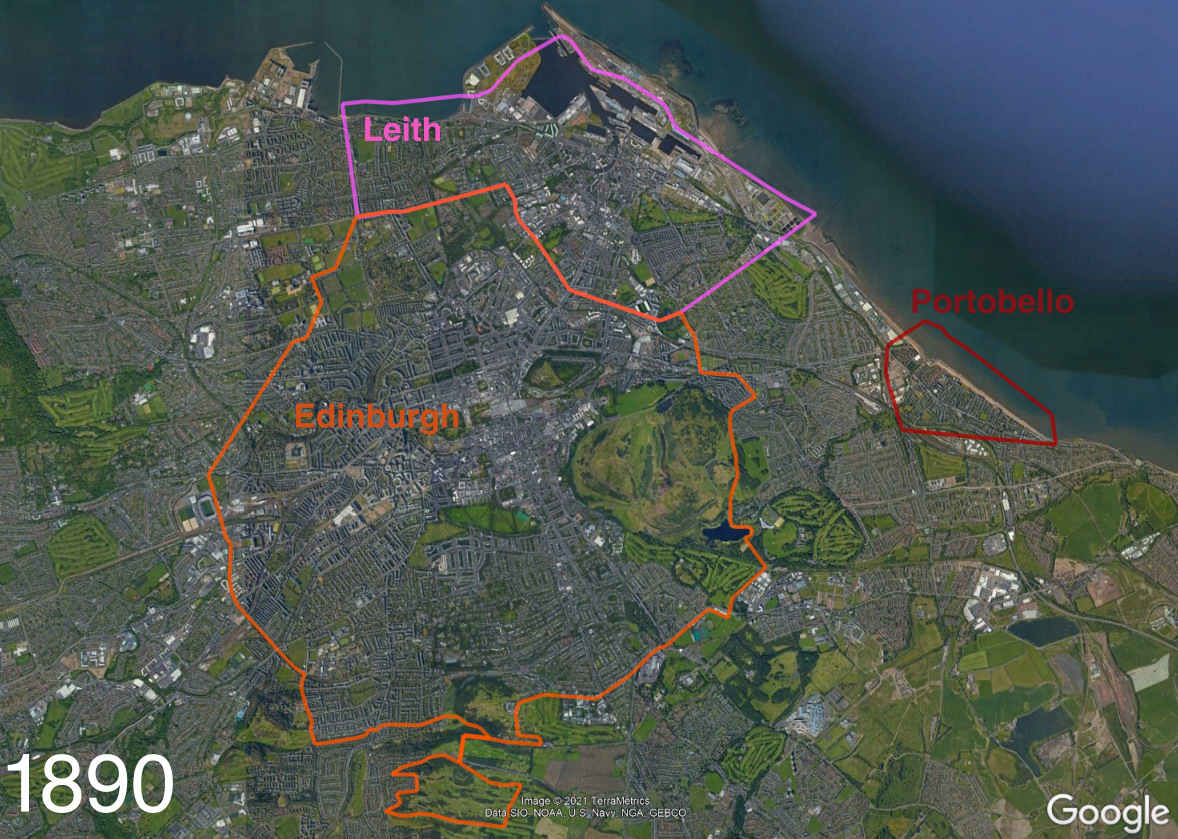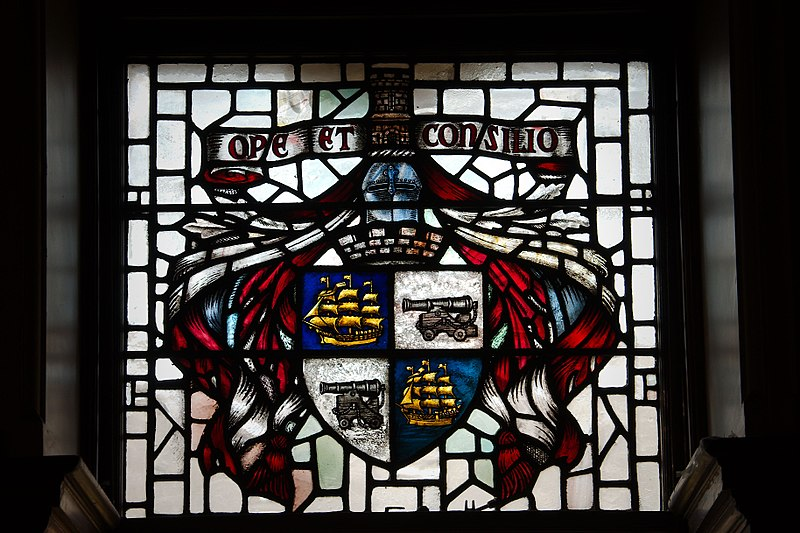🧵It's late O' Clock, so what better time for a brief 600 year whirlwind tour of the boundaries of Edinburgh. By this I mean the civil boundaries (by various definitions), not church parish or electoral ones (although they may overlap and be one and the same). 👇
In the 15th century, the extent of Edinburgh is a small place, whose civil reach is defined by the "King's Walls". Immediately to its east is the 12th century Burgh of the Canongate (owned by Holyrood Abbey), and to its north the Burghs of Barony of Restalrig and Broughton. 

After the national calamity at The Battle of Flodden, the town walls are "hurriedly" rebuilt (it takes about 45 years to complete!) due to the imminent threat of English retribution. This "Flodden Wall" expands the city boundaries significantly south 

As defensive structures, these medieval style walls were not suitable for the realities of 16th century warfare and both English and Scottish armies strolled into the city without too much effort in the 1540s, 50s and 70s.
Nevertheless, the walls were useful in defining and regulating the city, particularly as a protective trade barrier, something the city guarded zealously and jealously.
In 1618 the walls were reinforced and expanded again by the mason John Taillefer - the Telfer Walls - and in 1636 the superiority of the Burgh of Canongate was purchased by Edinburgh, although it would remain quasi-independent for the next 200 or so years. 

In 1649, the city got a new neighbour on its western fringe as the little village of Portsburgh outside the West Port (a port being a gateway in Scots placenames) was raised to a Burgh of Barony. 

n.b. a Burgh of Barony was a type of burgh in Scotland, distinct from a Royal Burgh like Edinburgh. granted to a feudal landowner. They gave the landowner certain rights and privileges regarding holding markets and/or dispense local justice.
In 1685, the Town Council defined 16 districts in the city, each to be "watched" by a company of the Trained Bands. Effectively these were law enforcement areas, the Trained Bands being a sort of militia force for protecting the city. This extended the civil reach north 

The City reiterated these districts in 1736 and in 1785 an Act of Parliament by King George III formalised these boundaries area as defining "The Ancient Royalty of the City"
The 17th century story of the decline of the Barony of Restalrig is a different story, but in 1725 the superiority of the ancient Calton district was bought from it, the west portion by Edinburgh and the east by the Heriot's Hospital (a far bigger landowner than the City) 

In 1767 the city finally squeezes itself beyond its ancient boundaries with the 1767 Police Boundaries Act that defines both the 1st New Town and attached exclaves. At this time Policing was a civic notion concerned with public sanitation, lighting etc., not law enforcement. 

These boundaries can be seen to be a complete mess, and resulted in parts of Calton being in the South Leith parish for worship, parts of Edinburgh in Broughton, etc.
Nevertheless, things proceeded in a haphazard manner, with individual Acts of Parliament in 1785, '86, 1809 and 1814 slowly attached bits on to the city, the most contiguous being the incorporation of the 2nd New Town. The northern exclave was for the Edinburgh Academy. 

In 1832 there was a huge change, with the Edinburgh Police Act (for "watching, lighting, cleansing and paving") tidying up and greatly expanding both the civic boundary and the municipal responsibilities. 

Much of the new boundary aligned with the new parliamentary boundary defined in the Representation of the People (Scotland) Act 1832 - the Scottish Reform Act. But not totally, as the section northeast of Broughton was actually in Leith for electoral purposes (map from NLS). 

In 1833 another new neighbour appears, with Portobello being raised to a burgh by Act of Parliament. Note that Broughton, Portsburgh and Canongate still exist for certain civic functions at this time, although Edinburgh had the Police powers over them. 

In 1854, the Edinburgh Police Amendment Act extends the boundary to include all of the extent of the Queen's Park, including Duddingston Loch. 

In 1856 the Edinburgh Municipality Extension Act swallows up the remaining civic functions and thereby abolishes the old Burghs of Broughton, Canongate and Portsburgh. In return Edinburgh loses a northern slice as Leith realises its 300-odd year campaign for burgh recognition. 

At 7.8 square kilometres, the new Burgh of Leith is 60% smaller than Edinburgh by size, but is seen by the City as a huge threat to its prosperity. They hadn't spent the last 400 or so years in more or less direct control of the port and its two parishes for no good reason.
Edinburgh now goes on a growing spree. The 1882 Municipal and Police Extension Act widens the city to the south and west. 

The 1889 Local Government Scotland Act brings in new powers that allow expansion under certain circumstances without recourse to an Act of Parliament each time. In 1890 this gives the city Braid Hill and an extra chunk of Inverleith when this was acquired from the Rocheid family. 

Note that the Braid Hill acquisition included the pathway up from the Hermitage of Braid, so this was a contiguous part of the city and not an exclave (OS 1892 25 inch survey via NLS) 

Hearts were broken in the People's Republic of Portobello and Joppa in 1896 when Edinburgh acquired that particular Burgh. The London Road between the two was also part of the deal, so again this was not an exclave. The western boundary also pushed further out again. 

In 1901, the lands of Craigentinny, once part of the Barony of Restalrig, between South Leith and the London Road were incorporated. This area at the time was largely unpopulated farmland and "irrigated meadows" (pasture land fed by raw sewage) 

Thanks to some idioticly microscopic changes in the Twitter UI, the muscle memory of how to do a thread has been broken, and this thread broke at this point last night. So I've deleted everything after and will now retweet. Thanks guys. You sure earned your Standup points.
Granton too joined the City Burgh in 1901 from Midlothian County, and by 1902 the remains of the old Parish of Duddingston were also acquired between the London Road in the north and the Niddrie / Brunstane Burns in the south. 

Then the Edinburgh Boundaries Extension and Tramways Act 1920 saw the city get revenge on the Leith Independence movement as it reacquired the entire burgh against widespread popular opposition. This is something which Leith has still not forgiven, 100 years later. 

But it wasn't just Leith, the same act gave Edinburgh the Barony of Corstorphine, and the civil parishes of Cramond, Liberton and Gilmerton from Midlothian. This boundary still defines a lot of what we think of as Edinburgh (and some bits we don't, like Straiton and Old Pentland)
Things would stay more or less as they were for the next 54 years, until the 1974 local government reforms created Lothian Region, with Edinburgh, Mid-, West and East Lothian being districts within that. But that's outwith my area of interest. flickr.com/photos/petered…
The City Coat of Arms has the castle, for obvious reasons, the anchor (as the Lord Provost is the Admiral of the Forth), the maiden as the Castle and its Rock was once known as the Maiden Castle/ Maidencraig and the deer represents St. Giles' life of solitude in the forest. 

Top marks to whichever jobsworth from Health and Safety stuck the fire escape sign over that glass... The Latin civic motto of "Nisi Dominus Frustra" is an abbreviation of Psalm 127.
Roughly speaking it translates to English as "Except the LORD build the house, they labour in vain that build it: except the LORD keep the city, the watchman waketh but in vain." Appropriate for a God-fearing 1640s Edinburgh.
The Canongate Burgh Coat of Arms features the white stag and cross that give rise to the popular story of the Holyrood placename - recall that Canongate once belonged to the Holyrood Abbey.
The motto "Sic Itur Ad Astra" translates to "Thus one goes to the stars"
The motto "Sic Itur Ad Astra" translates to "Thus one goes to the stars"

The Leith Burgh Coat of Arms, represents the Virgin Mary (for whom South Leith's Kirk was dedicated) and baby Jesus in a ship underneath a cloud. It is a late Victorian re-imagining of the 16th c. Burgh of Barony seal. The motto "Persevere" is well kenned, but modern (Victorian) 

The Latin "Siccilum Oppidi De Leith" means nothing more than "Seal of the Town of Leith" and is straight from the old seals. 1563 is the date Mary Queen of Scots wrote permission for Leith to raise its own Tolbooth, although at the time it never made independent Burgh status 

The Portobello arms were granted in 1886. "the ships represent the port (Porto) and the cannons, war (Bello)" The castle refers not to Edinburgh but apparently to that of Puerto Bello and the battle thereof, from where the name of the Burgh is derived. 

The Latin motto "Ope et Consilio" translates as "With help and counsel" and refers apparently to "the skillful manner in which Admiral Vernon and his colleagues captured [Puerto Bello]." 

As far as I'm aware Portsburgh never had a coat of arms, but its seal survives in the collections of the National Museum of Scotland. Appropriately it shows a town under a clifftop castle, a city wall and two gates (ports). And a heap of doves. 

I am unaware of arms for Broughton or Restalrig, I assume that instead the landowner used their own. For much of their time, for Broughton this was the Bellendens (no sniggering at the back, it's the old form of Ballantyne) and Restalrig this was the Logans.
Restalrig's own history is involved and complicated. There's a bit of a summary of it here 🧵👇; threadreaderapp.com/thread/1153994…
And that's probably as good a place as any to wrap this thread up. 🔚
threadreaderapp.com/thread/1461123… Thread reader version as a single page. 👆
• • •
Missing some Tweet in this thread? You can try to
force a refresh
















